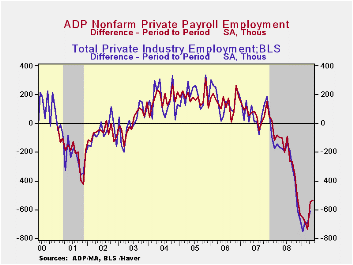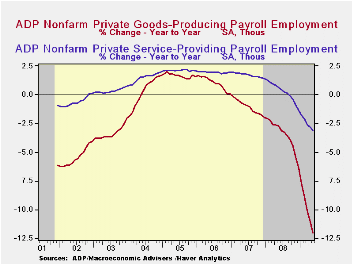 Global| Jun 03 2009
Global| Jun 03 2009ADP Report: Rate Of Job Loss Moderates
by:Tom Moeller
|in:Economy in Brief
Summary
No doubt the job market has yet to materially improve. However, the latest report from the payroll processor ADP in their National Employment Report showed an easing in the rate of contraction. It indicated that private nonfarm [...]

 ADP reported that last month medium-sized payrolls fell 223,000 (-5.3% y/y) followed by a 209,000 (-4.0% y/y) worker decline in small sized payrolls. Large payrolls fell by 100,000 (-5.3% y/y). In the goods producing sector there were 267,000 fewer jobs in April (-12.0% y/y). Medium-sized payrolls fell 114,000 (-12.5% y/y) followed by a 98,000 (-11.4% y/y) shortfall in small-sized payrolls. Large payrolls fell 55,000 (-12.1% y/y). In the manufacturing sector alone, payrolls fell 149,000 (-11.8% y/y) and that rate of decline has been gaining steam.
Declines in employment in the service producing industry have lagged just slightly the factory sector's workforce contraction. The 265,000 (-3.1% y/y) decline last month was the fourteenth consecutive monthly decline. Medium-sized service payrolls fell 109,000 (-3.4% y/y) and small-sized payrolls were off 111,000 (-2.7% y/y). Large service producing payrolls dropped by 45,000 (-3.3% y/y).
The ADP National Employment Report data is maintained in Haver's USECON database; historical figures date back to December 2000. The figures in this report cover only private sector jobs and exclude employment in the public sector, which rose an average 11,083 during the last twelve months.
ADP reported that last month medium-sized payrolls fell 223,000 (-5.3% y/y) followed by a 209,000 (-4.0% y/y) worker decline in small sized payrolls. Large payrolls fell by 100,000 (-5.3% y/y). In the goods producing sector there were 267,000 fewer jobs in April (-12.0% y/y). Medium-sized payrolls fell 114,000 (-12.5% y/y) followed by a 98,000 (-11.4% y/y) shortfall in small-sized payrolls. Large payrolls fell 55,000 (-12.1% y/y). In the manufacturing sector alone, payrolls fell 149,000 (-11.8% y/y) and that rate of decline has been gaining steam.
Declines in employment in the service producing industry have lagged just slightly the factory sector's workforce contraction. The 265,000 (-3.1% y/y) decline last month was the fourteenth consecutive monthly decline. Medium-sized service payrolls fell 109,000 (-3.4% y/y) and small-sized payrolls were off 111,000 (-2.7% y/y). Large service producing payrolls dropped by 45,000 (-3.3% y/y).
The ADP National Employment Report data is maintained in Haver's USECON database; historical figures date back to December 2000. The figures in this report cover only private sector jobs and exclude employment in the public sector, which rose an average 11,083 during the last twelve months.The full ADP National Employment Report can be found here, and the ADP methodology is explained here.
| LAXEPA@USECON | May | April | Y/Y | 2008 | 2007 | 2006 |
|---|---|---|---|---|---|---|
| Nonfarm Private Payroll Employment (m/m Chg.) | -532,000 | -545,000 | -4.8% | -0.4 | 1.2% | 2.0% |
Tom Moeller
AuthorMore in Author Profile »Prior to joining Haver Analytics in 2000, Mr. Moeller worked as the Economist at Chancellor Capital Management from 1985 to 1999. There, he developed comprehensive economic forecasts and interpreted economic data for equity and fixed income portfolio managers. Also at Chancellor, Mr. Moeller worked as an equity analyst and was responsible for researching and rating companies in the economically sensitive automobile and housing industries for investment in Chancellor’s equity portfolio. Prior to joining Chancellor, Mr. Moeller was an Economist at Citibank from 1979 to 1984. He also analyzed pricing behavior in the metals industry for the Council on Wage and Price Stability in Washington, D.C. In 1999, Mr. Moeller received the award for most accurate forecast from the Forecasters' Club of New York. From 1990 to 1992 he was President of the New York Association for Business Economists. Mr. Moeller earned an M.B.A. in Finance from Fordham University, where he graduated in 1987. He holds a Bachelor of Arts in Economics from George Washington University.






